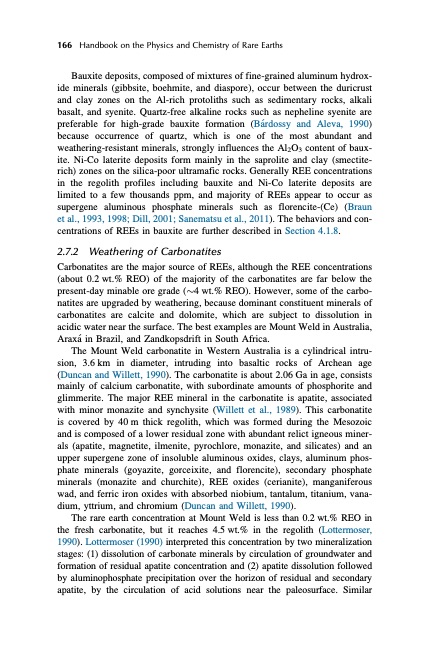
PDF Publication Title:
Text from PDF Page: 202
166 Handbook on the Physics and Chemistry of Rare Earths Bauxite deposits, composed of mixtures of fine-grained aluminum hydrox- ide minerals (gibbsite, boehmite, and diaspore), occur between the duricrust and clay zones on the Al-rich protoliths such as sedimentary rocks, alkali basalt, and syenite. Quartz-free alkaline rocks such as nepheline syenite are preferable for high-grade bauxite formation (Ba ́rdossy and Aleva, 1990) because occurrence of quartz, which is one of the most abundant and weathering-resistant minerals, strongly influences the Al2O3 content of baux- ite. Ni-Co laterite deposits form mainly in the saprolite and clay (smectite- rich) zones on the silica-poor ultramafic rocks. Generally REE concentrations in the regolith profiles including bauxite and Ni-Co laterite deposits are limited to a few thousands ppm, and majority of REEs appear to occur as supergene aluminous phosphate minerals such as florencite-(Ce) (Braun et al., 1993, 1998; Dill, 2001; Sanematsu et al., 2011). The behaviors and con- centrations of REEs in bauxite are further described in Section 4.1.8. 2.7.2 Weathering of Carbonatites Carbonatites are the major source of REEs, although the REE concentrations (about 0.2 wt.% REO) of the majority of the carbonatites are far below the present-day minable ore grade ($4 wt.% REO). However, some of the carbo- natites are upgraded by weathering, because dominant constituent minerals of carbonatites are calcite and dolomite, which are subject to dissolution in acidic water near the surface. The best examples are Mount Weld in Australia, Araxa ́ in Brazil, and Zandkopsdrift in South Africa. The Mount Weld carbonatite in Western Australia is a cylindrical intru- sion, 3.6km in diameter, intruding into basaltic rocks of Archean age (Duncan and Willett, 1990). The carbonatite is about 2.06 Ga in age, consists mainly of calcium carbonatite, with subordinate amounts of phosphorite and glimmerite. The major REE mineral in the carbonatite is apatite, associated with minor monazite and synchysite (Willett et al., 1989). This carbonatite is covered by 40 m thick regolith, which was formed during the Mesozoic and is composed of a lower residual zone with abundant relict igneous miner- als (apatite, magnetite, ilmenite, pyrochlore, monazite, and silicates) and an upper supergene zone of insoluble aluminous oxides, clays, aluminum phos- phate minerals (goyazite, gorceixite, and florencite), secondary phosphate minerals (monazite and churchite), REE oxides (cerianite), manganiferous wad, and ferric iron oxides with absorbed niobium, tantalum, titanium, vana- dium, yttrium, and chromium (Duncan and Willett, 1990). The rare earth concentration at Mount Weld is less than 0.2 wt.% REO in the fresh carbonatite, but it reaches 4.5 wt.% in the regolith (Lottermoser, 1990). Lottermoser (1990) interpreted this concentration by two mineralization stages: (1) dissolution of carbonate minerals by circulation of groundwater and formation of residual apatite concentration and (2) apatite dissolution followed by aluminophosphate precipitation over the horizon of residual and secondary apatite, by the circulation of acid solutions near the paleosurface. SimilarPDF Image | HANDBOOK ON THE PHYSICS AND CHEMISTRY OF RARE EARTHS

PDF Search Title:
HANDBOOK ON THE PHYSICS AND CHEMISTRY OF RARE EARTHSOriginal File Name Searched:
Chemistry-Rare-Earths-49.pdfDIY PDF Search: Google It | Yahoo | Bing
Sulfur Deposition on Carbon Nanofibers using Supercritical CO2 Sulfur Deposition on Carbon Nanofibers using Supercritical CO2. Gamma sulfur also known as mother of pearl sulfur and nacreous sulfur... More Info
CO2 Organic Rankine Cycle Experimenter Platform The supercritical CO2 phase change system is both a heat pump and organic rankine cycle which can be used for those purposes and as a supercritical extractor for advanced subcritical and supercritical extraction technology. Uses include producing nanoparticles, precious metal CO2 extraction, lithium battery recycling, and other applications... More Info
| CONTACT TEL: 608-238-6001 Email: greg@infinityturbine.com | RSS | AMP |